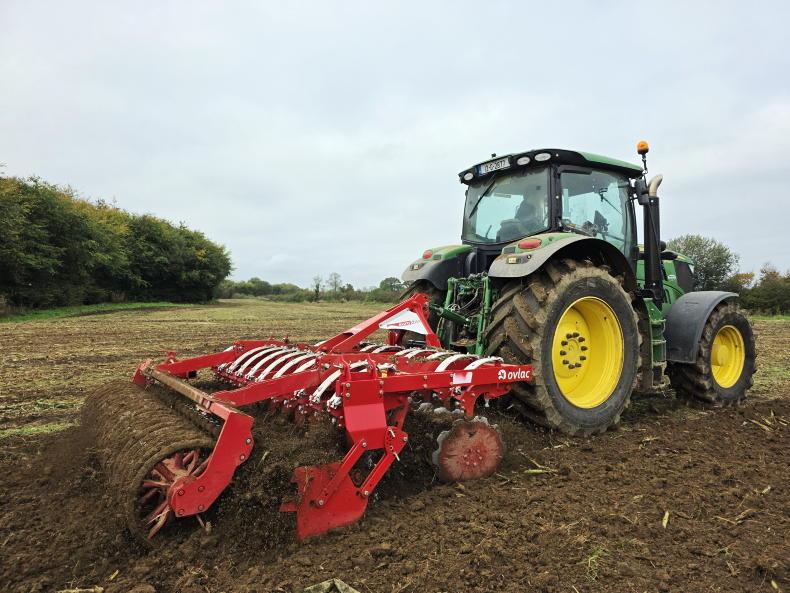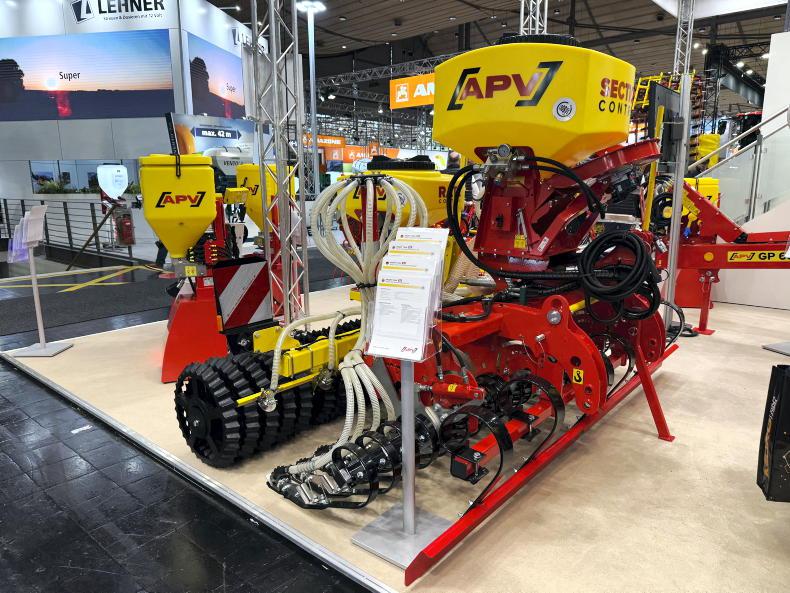It’s the age old debate, which is worse – lifting stones or cutting turf?
Having never experienced the joys of turf cutting, I can’t answer. However, after four days of lifting stones in a ploughed 10 acre field intended for reseeding, I would have been willing to swap the furrows for a peat bog.
Due to its stony nature, the field in question would have broken multiple tines on a power harrow. Therefore, we hired a Lemken cultivator.
After two runs not only did it leave an ideal seedbed but it also survived the experience unscathed. Most importantly, it didn’t bring up anywhere near the number of stones as a power harrow.
The field was then rolled, grass seed was sown with an EinbÖck drill and rolled again.
With a tightening weather window we were also able to direct drill a reseed into barley stubble. The weather conditions didn’t allow for an application of slurry as planned, and instead it received 50kg/acre of 16-16-16 (despite thinking that we were finished with the sower for the year).
Since then the grass has made steady progress but unfortunately so has volunteer barley. Hopefully, a light sheep grazing will help to ensure barley growth does not impair the development of the grass.
Dry cows
During a busy period on a farm it can be hard to prioritise tasks. In the midst of harvest I assumed that as dry cows on an outfarm weren’t due to calve for over a fortnight, it would be safe to leave their daily check until after tea.
Needless to say, this did not go as planned. On arrival, one of the girls was acting quite suspiciously. Although she wasn’t due to calve for 16 days, I could see a small amount of blood on her tail and her reaction suggested she was trying to keep the whereabouts of her newborn a secret (considering the field in question is a 17 acres, surrounded by overhanging whin bushes in fading light, this was an easy task).
After 20 minutes of looking, my suspicions were proven correct. With night closing in, I phoned for backup, and by 10pm my wife, mum and dad had cows out of the field, across the road, and down the lane and into the collecting yard.
It was then we realised another cow was missing. After half an hour we located the straggler, with another calf hidden in a hedge. Moving both mother and baby by torchlight is far from ideal but by 11.45pm we had everyone home, the cows milked, calcium boluses inserted, and babies fed. Needless to say, all cows and heifers within four weeks of calving are now housed.
Scour
Last winter we suffered an outbreak of scour in calves, and it is something that I would not want to experience again.
While in previous years we have had incidences of scour, these would normally be quickly restored with a course of electrolytes.
This outbreak was different and, frankly, unexpected as we have a closed herd, (with the exception of buying in a stock bull). As normal, we had practised infection control though regularly washing and disinfecting both calving pens and calf pens; all calves received 4 litres of colostrum at birth; iodine was sprayed on navels and good animal husbandry was generally observed.
Yet many calves were getting sick, and would go from being a picture of health to requiring a drip in a matter of two days. We lost several over this period.
The situation made me extremely frustrated and dejected. Through the guidance of our local vets, we started testing each case with a DIY scour diagnosis kit and were able to treat each calf accordingly (some had cryptosporidiosis while others had rotavirus).
We also started to vaccinate cows for rotavirus and coronavirus. Thankfully the cases of infected calves rapidly decreased and eventually stopped.
I am extremely grateful for how well my mother looked after each calf during the outbreak.
The situation would have much more severe without the care and attention she gave.
Read more
Farmer Writes: spring barley brings harvest to a close
Every day is a learning day in farming
It’s the age old debate, which is worse – lifting stones or cutting turf?
Having never experienced the joys of turf cutting, I can’t answer. However, after four days of lifting stones in a ploughed 10 acre field intended for reseeding, I would have been willing to swap the furrows for a peat bog.
Due to its stony nature, the field in question would have broken multiple tines on a power harrow. Therefore, we hired a Lemken cultivator.
After two runs not only did it leave an ideal seedbed but it also survived the experience unscathed. Most importantly, it didn’t bring up anywhere near the number of stones as a power harrow.
The field was then rolled, grass seed was sown with an EinbÖck drill and rolled again.
With a tightening weather window we were also able to direct drill a reseed into barley stubble. The weather conditions didn’t allow for an application of slurry as planned, and instead it received 50kg/acre of 16-16-16 (despite thinking that we were finished with the sower for the year).
Since then the grass has made steady progress but unfortunately so has volunteer barley. Hopefully, a light sheep grazing will help to ensure barley growth does not impair the development of the grass.
Dry cows
During a busy period on a farm it can be hard to prioritise tasks. In the midst of harvest I assumed that as dry cows on an outfarm weren’t due to calve for over a fortnight, it would be safe to leave their daily check until after tea.
Needless to say, this did not go as planned. On arrival, one of the girls was acting quite suspiciously. Although she wasn’t due to calve for 16 days, I could see a small amount of blood on her tail and her reaction suggested she was trying to keep the whereabouts of her newborn a secret (considering the field in question is a 17 acres, surrounded by overhanging whin bushes in fading light, this was an easy task).
After 20 minutes of looking, my suspicions were proven correct. With night closing in, I phoned for backup, and by 10pm my wife, mum and dad had cows out of the field, across the road, and down the lane and into the collecting yard.
It was then we realised another cow was missing. After half an hour we located the straggler, with another calf hidden in a hedge. Moving both mother and baby by torchlight is far from ideal but by 11.45pm we had everyone home, the cows milked, calcium boluses inserted, and babies fed. Needless to say, all cows and heifers within four weeks of calving are now housed.
Scour
Last winter we suffered an outbreak of scour in calves, and it is something that I would not want to experience again.
While in previous years we have had incidences of scour, these would normally be quickly restored with a course of electrolytes.
This outbreak was different and, frankly, unexpected as we have a closed herd, (with the exception of buying in a stock bull). As normal, we had practised infection control though regularly washing and disinfecting both calving pens and calf pens; all calves received 4 litres of colostrum at birth; iodine was sprayed on navels and good animal husbandry was generally observed.
Yet many calves were getting sick, and would go from being a picture of health to requiring a drip in a matter of two days. We lost several over this period.
The situation made me extremely frustrated and dejected. Through the guidance of our local vets, we started testing each case with a DIY scour diagnosis kit and were able to treat each calf accordingly (some had cryptosporidiosis while others had rotavirus).
We also started to vaccinate cows for rotavirus and coronavirus. Thankfully the cases of infected calves rapidly decreased and eventually stopped.
I am extremely grateful for how well my mother looked after each calf during the outbreak.
The situation would have much more severe without the care and attention she gave.
Read more
Farmer Writes: spring barley brings harvest to a close
Every day is a learning day in farming









SHARING OPTIONS